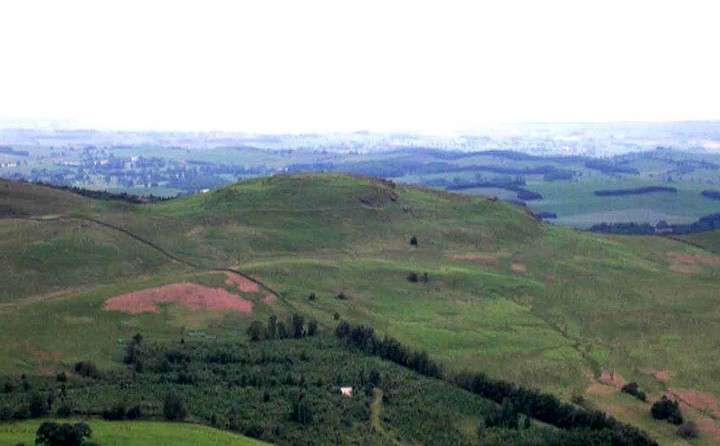Hillfort: OS Grid Reference – SD 963 558
Also Known as:
- MYD1636
Travel up the B6265 (Skipton to Grassington road) for a mile, watching on the small hills on your left (western) side, and then take the left turn up to Sandy Beck. You can’t miss the place!
Archaeology & History

My first view of this place was from the hills east of here, atop of one of the great rock outcrops on the edge of Embsay Moor. The very first impression it gave me was – “That’s a bloody hillfort!”: an obvious worked rounded hill, with ridges typical of such monuments. Subsequent investigation found that there were extensive remains of walling, more typical of the Iron Age period than the neolithic (which some modern archaeologists have proposed), clearly visible around the edges of this great hill. The structure of the site is similar in size and design to the remains at the nearby Horse Close Hill above Skipton, aswell as another (officially unknown) site closer to Keighley. A large overgrown cairn rests on the southern side of the hill, seemingly more of archaic import than a mere clearance or marker point. But I may be wrong…
Very notable at this site are the profusion of springs emerging from all round Rough Haw: the blood of seven such water sources comes from its edges on all sides and would obviously have been of some importance here.
References:
Dixon, John & Phillip, Journeys through Brigantia – volume 1: Walks in Craven, Airedale and Wharfedale, Aussteiger Publications: Barnoldswick 1990.
Links:
- Out of Oblivion: Rough Haw Archaeological Notes – An archaeocentric description of this little-known site, ascribing it as perhaps Bronze Age, perhaps Neolithic.
© Paul Bennett, The Northern Antiquarian
SHARP HAW ENCLOSURE
This enclosure is classified as a defensive, Iron Age, hill top site, built from and around a series of glacial eratics. The site may have served as a redoubt for the major pre-Roman settlement site at Gargrave, brought into use only in times of conflict when people and stock could be brought up onto the highlands for defence and safety.
The Craven Museum at Skipton displays two major finds from Rough/Sharp Haw: a Lower Bronze Age spearhead and an Iron Age sword and scabbard, the sword is iron, the scabbard bronze with a wooden lining.
A small cairn on the rise to the north of Rough Haw SD 963 563, constructed of local gritstone boulders, the largest being robbed for local walling, was excavated in 1964. It was founmd to rest upon an old turf-line with undisturbed podsoil section continuous beneath it. At its centre were found many burned flaggy grits, but no trace of any burial.
See: JOURNEYS THROUGH BRIGANTIA Vol 1, Craven, Airedale & Wharfedale. 1990. John Dixon, AUSSTEIGER PUBLICATIONS. pp. 53 to 71.